
Concept explainers
(a)
Interpretation:
The principal organic product that is obtained when
Concept introduction:
The reaction in which an atom of
Answer to Problem 26.26AP
The principal organic product that is obtained when

Explanation of Solution
The reaction of

Figure 1
In the above reaction, the second position of
Therefore, the product formed by the above reaction is
The principal organic product,
(b)
Interpretation:
The principal organic product that is obtained when
Concept introduction:
The reaction in which an atom of aromatic system is replaced by an electrophile is known as electrophilic aromatic substitution reaction. The compound, acetic anhydride behaves as a acetylating compound in the presence of
Answer to Problem 26.26AP
The principal organic product that is obtained when

Explanation of Solution
The reaction of

Figure 2
In the above reaction, the second position of
Therefore, the product formed by the above reaction is
The principal organic product,
(c)
Interpretation:
The incomplete reaction between diene and dienophile is to be completed with the reasonable products. The reason corresponding to the formation of the correct product is to be explained.
Concept introduction:
Diels Alder reaction is the
Answer to Problem 26.26AP
The complete reaction is shown below.
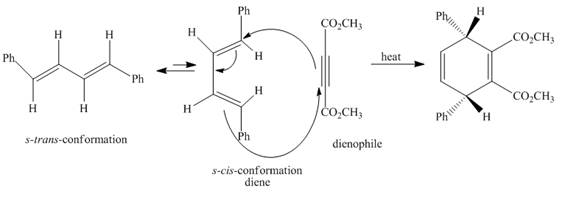
Explanation of Solution
The given incomplete reaction is shown below.

Figure 3
In the above incomplete reaction, the given
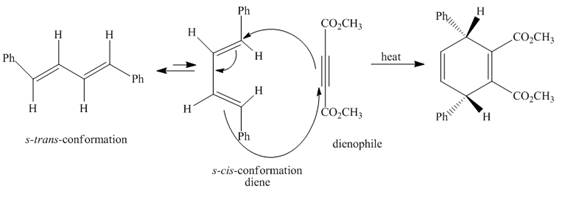
Figure 4
Therefore, one product is obtained from the above shown Diels Alder reaction.
The complete reaction corresponding to the incomplete reaction between diene and dienophile is shown in Figure 4.
(d)
Interpretation:
The incomplete reaction between an alkene and benzoquinone is to be completed with the reasonable products. The reason corresponding to the formation of the correct product is to be explained.
Concept introduction:
Diels Alder reaction is the
Answer to Problem 26.26AP
The complete reaction is shown below.

Explanation of Solution
The given incomplete reaction is shown below.
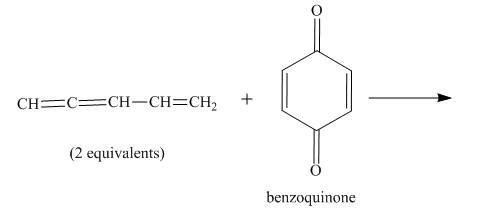
Figure 5
In the above incomplete reaction, the given two equivalents of alkene behaves as a diene and undergoes Diels Alder reaction with benzoquinone which behaves as a dienophile in the presence of heat to form two products as shown below.

Figure 6
Therefore, two products are obtained from the above shown Diels Alder reaction. The second product is the major one because of the less van der Waals repulsion present in between two double bonds which are exocyclic.
The complete reaction corresponding to the incomplete reaction between diene and dienophile is shown in Figure 6.
(e)
Interpretation:
The incomplete reaction between a diene and a dienophile is to be completed with the reasonable products. The reason corresponding to the formation of the correct product is to be explained.
Concept introduction:
Diels Alder reaction is the
Answer to Problem 26.26AP
The complete reaction is shown below.
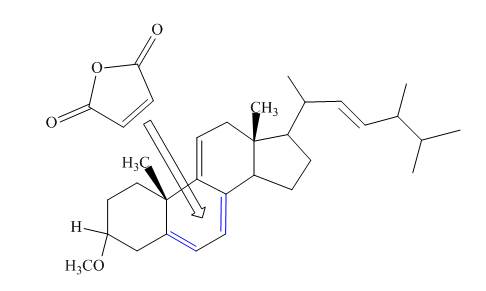
Explanation of Solution
The given incomplete reaction is shown below.
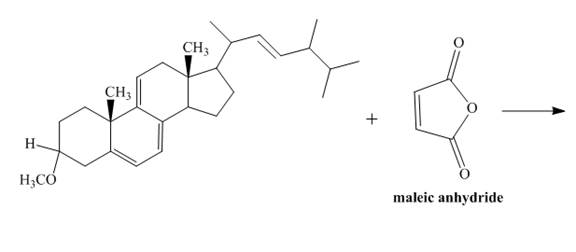
Figure 7
Only the

Figure 8
The above reaction does not form any product because the
Therefore, no product is formed in the above shown reaction.
There is no formation of the product takes place in the given reaction.
(f)
Interpretation:
The incomplete reaction between a diene and a dienophile is to be completed with the reasonable products. The reason corresponding to the formation of the correct product is to be explained.
Concept introduction:
Diels Alder reaction is the
Answer to Problem 26.26AP
The complete reaction is shown below.
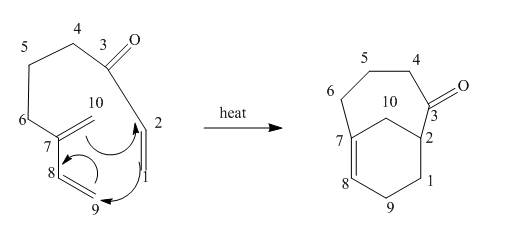
Explanation of Solution
The given incomplete reaction is shown below.

Figure 9
In the above incomplete reaction, the intramolecular Diels Alder reaction takes place in the presence of heat to form two products as shown below.

Figure 10
In the above reaction, diene and dienophile are present in the same compound. Therefore, two products are obtained from the above shown Diels Alder reaction. Therefore, the shifting of bonds takes place within the molecule to form a single product.
The complete reaction corresponding to the incomplete reaction between diene and dienophile is shown in Figure 10.
(g)
Interpretation:
The incomplete reaction between nickel choride and
Concept introduction:
Metallocene compounds are composed of an electropositive metal ions specially
Answer to Problem 26.26AP
The complete reaction is shown below.
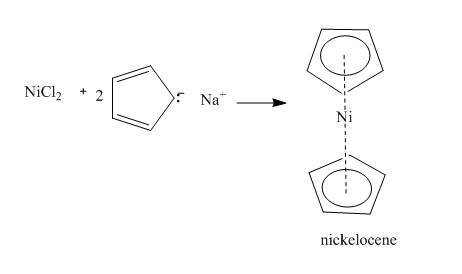
Explanation of Solution
The given incomplete reaction is shown below.
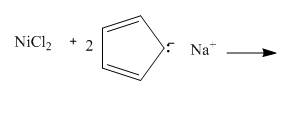
Figure 11
In the above incomplete reaction, the nickel chloride reacts with

Figure 12
Therefore, the reaction between nickel chloride and
The complete reaction corresponding to the incomplete reaction between nickel choride and
Want to see more full solutions like this?
Chapter 26 Solutions
Organic Chemistry, Ebook And Single-course Homework Access
- Homework 4 Chem 204 Dr. Hellwig Consider this compound, which will be referred to as "your compound". a) Name your compound according to the IUPAC system. Include stereochemistry (E/Z/R/S) H CH3 CH3arrow_forwardWhat is the mechanism for this?arrow_forward21.50 Determine the combinations of haloalkane(s) and alkoxide(s) that could be used to synthesize the following ethers through Williamson ether synthesis. (a) (c) (d) (e) (f) H₂COarrow_forward
- 1. Arrange the following in order of increasing bond energy (lowest bond energy first, highest bond energy last). Provide your rationale. C=C, C-F, C=C, C-N, C-C List the bond order for each example.arrow_forwardWhat is the major enolate formed when treated with LDA? And why that one?arrow_forward4. Calculate the total number of sigma bonds and total number of pi bonds in each of the following compounds. a. HH :D: +1 I H-N-C-C-O-H I H b. HH H Н :N=C-C-C=C-CEC-H :0: total o H-C-H H-C = `C-H I H. 11 H-C = C= CH H total o total π total π 1 Harrow_forward
- In the following reaction, what quantity in moles of CH₃OH are required to give off 4111 kJ of heat? 2 CH₃OH (l) + 3 O₂ (g) → 2 CO₂ (g) + 4 H₂O(g) ∆H° = -1280. kJarrow_forwardIndicate the processes in the dismutation of Cu2O.arrow_forward1. Consider these three reactions as the elementary steps in the mechanism for a chemical reaction. 2600 2400 2200 2000 1800 1600 1400 1200 1000 800 Potential Energy (kJ) 600 400 200 0 -200- -400 -600- -800 (i) Cl₂ (g) + Pt(s) → 2Cl (g) + Pt(s) (ii) Cl (g)+ CO (g) + Pt (s) → CICO (g) + Pt (s) Ea = 1550 kJ Ea = 2240 kJ (iii) Cl (g) + CICO (g) → Cl₂CO (g) Ea = 2350 kJ AH=-950 kJ ΔΗ = 575 ΚΙ AH=-825 kJ a. Draw the potential energy diagram for the reaction. Label the data points for clarity. The potential energy of the reactants is 600 kJ Reaction Progress b. What is the overall chemical equation? c. What is the overall change in enthalpy for the above chemical reaction? d. What is the overall amount of activation energy for the above chemical reaction? e. Which reaction intermediate would be considered a catalyst (if any) and why? f. If you were to add 2700kJ of energy to the reaction (e.g. 2700 kl of heat or electricity), would you be able to make the reaction reverse itself (i.e. have…arrow_forward
- draw the enolate anion and the carbonyl that would be needed to make this product through an aldol addition reaction.arrow_forwardDraw the Michael Adduct and the final product of the Robinson annulation reaction. Ignore inorganic byproducts.arrow_forwardDraw the Michael adduct and final product of the Robinson annulation reaction. Ignore inorganic byproductsarrow_forward

 Organic ChemistryChemistryISBN:9781305580350Author:William H. Brown, Brent L. Iverson, Eric Anslyn, Christopher S. FootePublisher:Cengage Learning
Organic ChemistryChemistryISBN:9781305580350Author:William H. Brown, Brent L. Iverson, Eric Anslyn, Christopher S. FootePublisher:Cengage Learning

